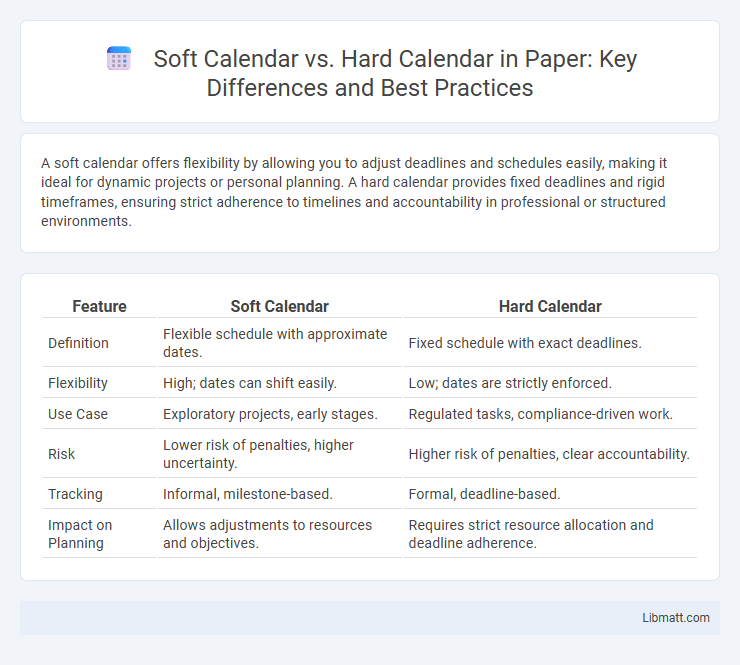A soft calendar offers flexibility by allowing you to adjust deadlines and schedules easily, making it ideal for dynamic projects or personal planning. A hard calendar provides fixed deadlines and rigid timeframes, ensuring strict adherence to timelines and accountability in professional or structured environments.
Table of Comparison
| Feature | Soft Calendar | Hard Calendar |
|---|---|---|
| Definition | Flexible schedule with approximate dates. | Fixed schedule with exact deadlines. |
| Flexibility | High; dates can shift easily. | Low; dates are strictly enforced. |
| Use Case | Exploratory projects, early stages. | Regulated tasks, compliance-driven work. |
| Risk | Lower risk of penalties, higher uncertainty. | Higher risk of penalties, clear accountability. |
| Tracking | Informal, milestone-based. | Formal, deadline-based. |
| Impact on Planning | Allows adjustments to resources and objectives. | Requires strict resource allocation and deadline adherence. |
Understanding Soft Calendars and Hard Calendars
Soft calendars offer flexibility by allowing adjustments to deadlines and schedules, making them ideal for dynamic projects and environments where priorities may shift. Hard calendars enforce fixed dates and strict timelines, ensuring accountability and precise planning in scenarios that require firm commitments. Understanding the differences between soft calendars and hard calendars helps you select the best approach for managing your time and resources effectively.
Key Differences Between Soft and Hard Calendars
Soft calendars offer flexible scheduling options that accommodate changes and rescheduling without significant disruption, making them ideal for dynamic projects and adaptive workflows. Hard calendars provide fixed, non-negotiable deadlines and milestones, ensuring strict adherence to timelines and clear accountability in project management. The key difference lies in the adaptability of soft calendars versus the rigidity of hard calendars, affecting resource allocation, risk management, and overall project control.
Advantages of Using a Soft Calendar
Using a soft calendar offers flexible scheduling options that adapt to changing priorities and unexpected tasks, enhancing time management efficiency. It enables easy editing and real-time updates accessible across multiple devices, promoting collaboration and productivity. Soft calendars often integrate with other digital tools, streamlining workflow and reducing the risk of overlooked appointments or deadlines.
Benefits of Implementing a Hard Calendar
Implementing a hard calendar ensures strict adherence to deadlines, improves project transparency, and facilitates effective resource allocation. It minimizes the risk of scope creep and delays by enforcing fixed timelines and milestones. Organizations benefit from increased accountability and streamlined workflow management when using a hard calendar.
When to Choose a Soft Calendar Approach
A soft calendar approach is ideal when project flexibility and adaptability are crucial, such as in creative industries or software development where requirements frequently evolve. You should choose a soft calendar to accommodate changes without causing significant disruptions to the timeline, allowing teams to adjust tasks and deadlines as new information emerges. This method prioritizes collaboration and iterative progress over rigid schedules, enhancing productivity in dynamic environments.
Scenarios Ideal for Hard Calendar Scheduling
Hard calendar scheduling is ideal for projects with fixed deadlines, regulatory compliance, or contractual obligations that demand strict timelines and milestone adherence. It ensures precise resource allocation and progress tracking when delays can lead to significant financial or legal penalties. Your team benefits from clear, unwavering schedules that reduce ambiguity and improve accountability in high-stakes environments.
Impact on Productivity: Soft vs Hard Calendars
Soft calendars enhance productivity by offering flexibility in scheduling, allowing adjustments to accommodate unexpected tasks and prioritize urgent activities efficiently. Hard calendars, while providing structure and clear deadlines, can limit adaptability, potentially causing stress and reduced efficiency when rigid plans are disrupted. Organizations using soft calendars report improved time management and dynamic task allocation, leading to higher overall productivity compared to those relying strictly on hard calendar systems.
Flexibility and Rigidity: A Comparative Analysis
Soft calendars offer flexibility by allowing dates to shift based on project progress, resource availability, and unforeseen changes, making them ideal for dynamic environments. Hard calendars enforce rigidity with fixed deadlines and milestones, ensuring strict adherence to schedules but less adaptability to changes. This comparative analysis highlights soft calendars' advantage in accommodating variability, while hard calendars excel in maintaining control and predictability.
Tools and Apps Supporting Soft and Hard Calendars
Soft calendars are supported by digital tools like Google Calendar, Microsoft Outlook, and Apple Calendar, offering flexibility with real-time updates, drag-and-drop event management, and integration with email and task apps. Hard calendars rely on physical planners, wall calendars, or printable templates, favored for tactile interaction and offline use but lacking automated reminders and synchronization features. Hybrid solutions such as Rocketbook or reMarkable tablets blend soft and hard calendar advantages by digitizing handwritten notes while maintaining the traditional planner experience.
Best Practices for Integrating Calendar Strategies
Soft calendars allow flexibility in scheduling, enabling adjustments to accommodate unexpected changes, while hard calendars enforce fixed deadlines and structured timelines. Best practices for integrating these calendar strategies include prioritizing critical tasks with hard deadlines and using soft calendars to manage less time-sensitive activities, which enhances overall time management and reduces stress. Incorporating buffer periods and frequent reviews helps you maintain balance and adapt to shifting priorities effectively.
Soft calendar vs hard calendar Infographic

 libmatt.com
libmatt.com